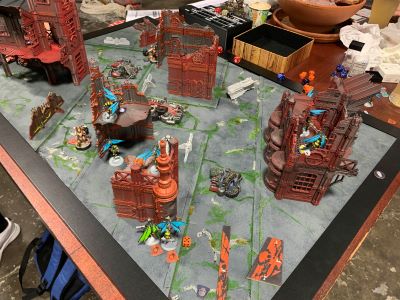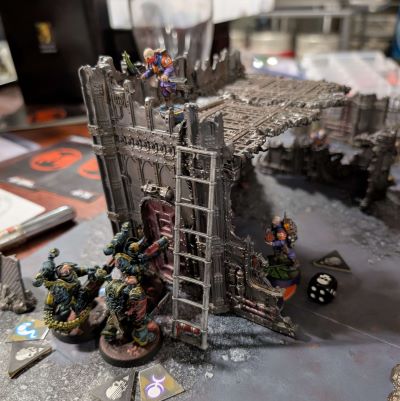Back in April and May I ran a narrative Kill Team event called Promethium War. We had 12 players all fighting over the Promethium rich world of Pyrothis V. The aim of the campaign was to keep it simple, push the narrative side of the game and see what it is like to run an experience like this. I purposely kept it short at 4 weeks so that I could dip my toe in the water and understand what works and what doesn’t. Of course, I also wanted to make sure people at the club were really interested.
Did it work and what lessons did I learn? Lets find out.
What Worked?
To start with we had 12 club goers sign up for the campaign. So there was real interest in the narrative side of the game. People were excited about giving more meaning to their casual Wednesday night games.
Having factions and teams working together created lots of banter and feedback from the participants rated this as an enjoyable part of the whole experience. The exception to this was the different win conditions for the Xenos team, which didn’t really work as well as I had hoped.
Most of the players really engaged with the narrative elements of the campaign and wrote up fun battle reports. They weren’t shy about putting their own spin on the campaign events, resulting in some really creative additions.
All in all, lots of engagement, fun banter and some great narrative. An all round win. However, there were some elements that could have gone better.

What Didn’t Work?
As mentioned above the Xenos faction win condition was confusing and actually difficult to pull off. To their credit the Xenos players leaned into it well, but if I were to do it again I would have their win condition be more aligned with the other two factions.
Scoring was based only on wins. Looking back, I think that points should be scored for playing games as well, not just the win. this encourages players to get more games in and removes the sting of defeat a little.
During Promethium War all the narrative elements were collected as stories in the discord and the weekly campaign journal. Having a map would have grounded the games even more with actual territory being fought over. Whether this needs actual mechanics associated with it or stays as a tool to aid the narrative remains to be seen.
In my set up of the campaign I added a couple of bespoke crit ops. However, I feel like I missed a trick here. Having a strong of specific ops can really help tell the story of the campaign. The scientist mission I included was a real hit. Having things like this that deviate from the regular game set up gave additional life to the campaign.
Campaign Journal
Inspired by the old Necromunda newsletters from the 1990s White Dwarf magazine, I wrote a series of campaign journals. These were intended to tell the story of the campaign, including results and missions. These took a fair bit of work to compile and I’m not sure that the players really engaged with them. From an effort/reward point of view I’m not sure they are worth it. Next time I think I will do something similar but a lot shorter.
If you want to follow the campaign here are the journals from Week 1 to the finale:
Lessons Learned from Promethium War
From my own experience and from my player survey there are a few things I’d do next time. these include:
- Include a map to fight over (though with limited mechanics)
- Keep multiple factions, but keep win conditions more aligned
- Appoint Faction Captains to encourage engagement and narrative
- Include secret missions for Factions to give a sense of mystery
- Have a specific mission for each week that follows the arc of the campaign
- Include environmental rules to make battles feel different
- Have a reduced campaign journal, rely on players and captains to provide the narrative
- Include specific events during the campaign with special missions and multiplayer games to maintain interest and give different experiences throughout
- Make it longer than 4 weeks to give more of a feeling of a larger scale campaign.

Final Thoughts on Promethium War
Did Promethium War work? Yes it did. The players were engaged and had fun, which is after all the purpose of the whole experience. Additionally I learned a lot about the effort required and other things that the players were looking for.
Would I run another narrative campaign? Definitely! Would I recommend running your own narrative campaign? Definitely again. However, the set up does take quite a bit of work. Watching players engage with your material and make it there own is a very satisfying experience.
While writing this I already have the makings of the next campaign already forming. Get ready for Succession War (working title) later in the year. Cant wait to see what story emerges.



